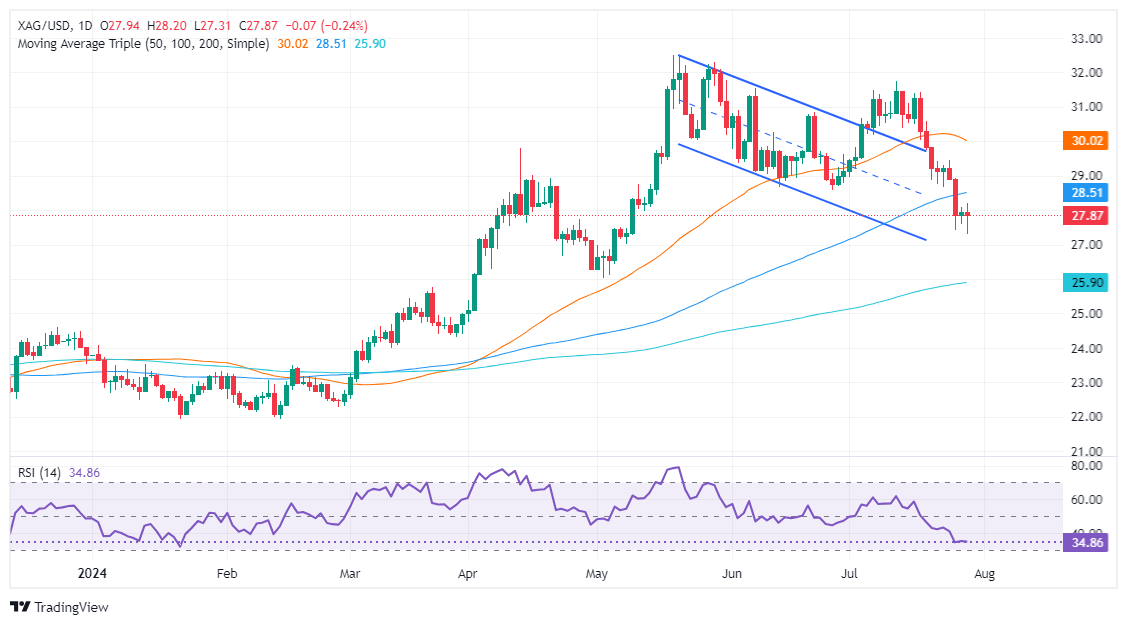Silver Price Analysis: XAG/USD falls and consolidates below $28.00
- Silver prices tumble below 100-DMA at $28.49, trading at $27.86.
- Bearish RSI suggests further declines, with first support at $27.31 and psychological level at $27.00.
- Resistance seen at $29.00, with potential for higher prices if buyers regain control.
Silver prices traded within the 80 cents trading range, yet they lost close to 0.20% on Monday, as traders braced for a busy US economic schedule that would include crucial events such as the Federal Reserve’s monetary policy decision and the latest Nonfarm Payrolls report. The XAG/USD exchanged hands at $27.86, below its opening price.
XAG/USD Price Analysis: Technical outlook
Silver's price tumbled below the 100-day moving average (DMA) at $28.49, opening the door for lower spot prices. Momentum is bearish, as depicted by the Relative Strength Index (RSI), an indication that the non-yielding metal could test lower prices.
The XAG/USD's first support would be the July 29 low of $27.31, followed by the $27.00 psychological level. A breach of the latter will expose the latest cycle low, the May 2 bottom at $26.02, before testing the 200-DMA at $25.89.
Conversely, if buyers moved in and pushed Silver’s price above $29.00, that could pave the way for higher prices. The next resistance would be the July 24 high at $29.44, ahead of $30.00.
XAG/USD Price Action – Daily Chart

Silver FAQs
Silver is a precious metal highly traded among investors. It has been historically used as a store of value and a medium of exchange. Although less popular than Gold, traders may turn to Silver to diversify their investment portfolio, for its intrinsic value or as a potential hedge during high-inflation periods. Investors can buy physical Silver, in coins or in bars, or trade it through vehicles such as Exchange Traded Funds, which track its price on international markets.
Silver prices can move due to a wide range of factors. Geopolitical instability or fears of a deep recession can make Silver price escalate due to its safe-haven status, although to a lesser extent than Gold's. As a yieldless asset, Silver tends to rise with lower interest rates. Its moves also depend on how the US Dollar (USD) behaves as the asset is priced in dollars (XAG/USD). A strong Dollar tends to keep the price of Silver at bay, whereas a weaker Dollar is likely to propel prices up. Other factors such as investment demand, mining supply – Silver is much more abundant than Gold – and recycling rates can also affect prices.
Silver is widely used in industry, particularly in sectors such as electronics or solar energy, as it has one of the highest electric conductivity of all metals – more than Copper and Gold. A surge in demand can increase prices, while a decline tends to lower them. Dynamics in the US, Chinese and Indian economies can also contribute to price swings: for the US and particularly China, their big industrial sectors use Silver in various processes; in India, consumers’ demand for the precious metal for jewellery also plays a key role in setting prices.
Silver prices tend to follow Gold's moves. When Gold prices rise, Silver typically follows suit, as their status as safe-haven assets is similar. The Gold/Silver ratio, which shows the number of ounces of Silver needed to equal the value of one ounce of Gold, may help to determine the relative valuation between both metals. Some investors may consider a high ratio as an indicator that Silver is undervalued, or Gold is overvalued. On the contrary, a low ratio might suggest that Gold is undervalued relative to Silver.